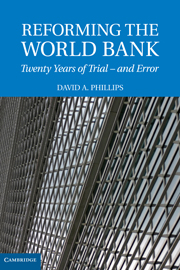Book contents
- Frontmatter
- Contents
- Preface: The Search for Effectiveness in the World's Premier Development Institution
- REFORMING THE WORLD BANK
- PART I ORIGINS AND EVOLUTION
- 1 What Does the World Bank Do and How Does It Do It?
- 2 Critique and Response
- PART II THE SEARCH FOR EFFECTIVENESS
- PART III TOWARDS REAL REFORM: THE GOVERNANCE AGENDA
- Index
2 - Critique and Response
Published online by Cambridge University Press: 25 January 2011
- Frontmatter
- Contents
- Preface: The Search for Effectiveness in the World's Premier Development Institution
- REFORMING THE WORLD BANK
- PART I ORIGINS AND EVOLUTION
- 1 What Does the World Bank Do and How Does It Do It?
- 2 Critique and Response
- PART II THE SEARCH FOR EFFECTIVENESS
- PART III TOWARDS REAL REFORM: THE GOVERNANCE AGENDA
- Index
Summary
EMERGING ISSUES
A complex financial institution emerged over sixty years, which has continued to operate throughout without any major threats to its survival, providing a model to other international financial institutions. The IBRD has had a continuous, apparently successful, record of evolving lending and knowledge services, delivered with a reasonable profit that has enabled it to provide subsidies to other agencies while expanding its expertise and maintaining a position as the world's premier development institution.
But the Bank's successes have also been built behind a protective wall and its low funding costs have allowed it to remain profitable even with large overheads and an annual payroll that would be enough to lift a small country out of the worst poverty. The layers of protection and a resulting perception of inadequate transparency have also tended to attract extra scrutiny of the Bank's work, and the level of success it has achieved with the resources it has at its disposal has been widely debated. For example, in June 2003, at the end of a period of major reform involving unprecedented outreach to its member countries, a poll of 2,600 ‘opinion leaders’ from around the world by Princeton Survey Research Associates found that large numbers of those surveyed had quite a dim view of the institution. Less than half of Africa's opinion leaders were happy with its work, and about 60% of South Asians and Middle Easterners. Somewhat better, over 70% of East Asians including Chinese thought it was doing well.
- Type
- Chapter
- Information
- Reforming the World BankTwenty Years of Trial - and Error, pp. 24 - 42Publisher: Cambridge University PressPrint publication year: 2009

